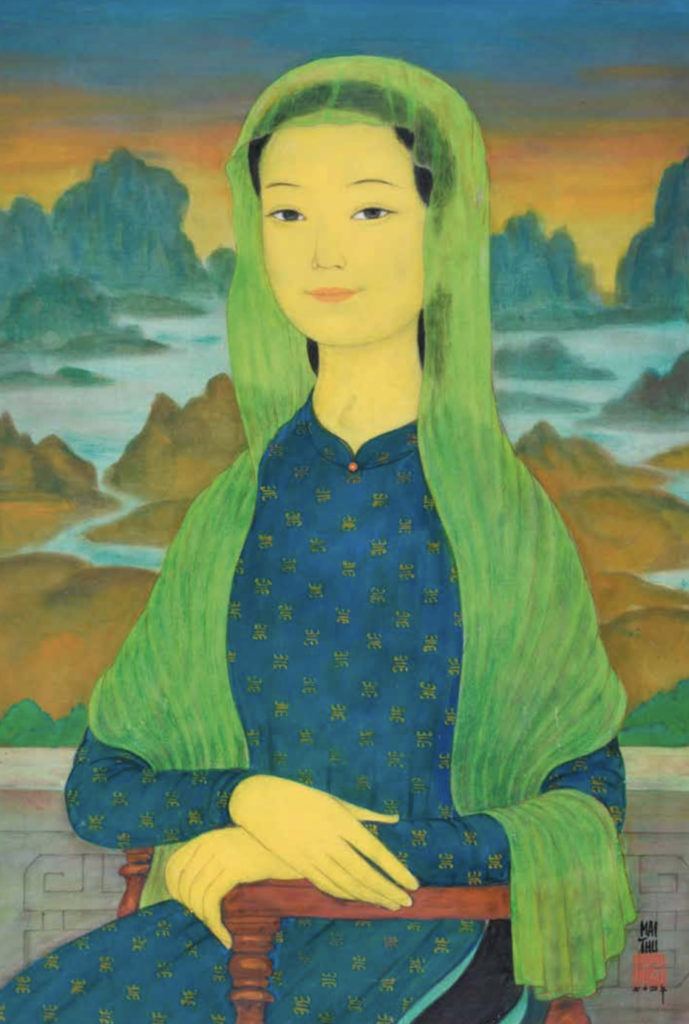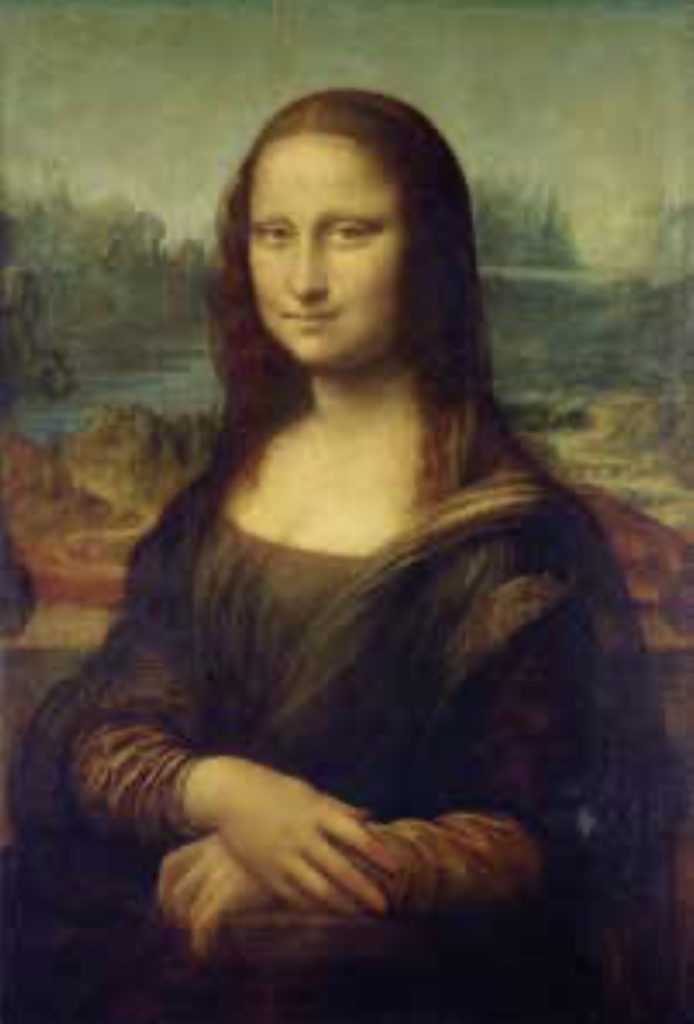Mai Thu, “La Joconde” (Mona Lisa), 1974, or the other one’s smile
Mai Trung Thu, in his career as an artist, has never hesitated though exceptionally, to confront himself pictorially with the great masters of the past. His version of La Grande Odalisque by Ingres (from the Tuan Pham Collection sold at Christie’s in Nov 2019) bears witness to this. This is confirmed by this magnificent La Joconde (Mona Lisa).
We can imagine Mai Thu discovering and visiting often the original Mona Lisa by Leonardo da Vinci at the Louvre, from his stay in Paris in 1937 to 1974, the date of execution of his own painting. There is
no doubt that he scrutinized it, in all the lights of day, in all seasons, indulging in a continuous and attentive observation. A piety. He is
68 years old, at the peak of his art (widely recognized) and yet, like a student in a workshop, he launches into the reproduction of the most famous painting in the world.

Mai Thu – La Joconde 
Leonardo Da Vinci – Mona Lisa
Let’s compare the two versions as their differences have meaning:
The general position is the same, the beautiful young woman is potrayed sitting. Only her head and upper body are depicted. Her bust is turned to the right, her face is facing the front, and there is a slight twist between her head and shoulders. In Mai Thu’s representation the bust is smaller, the body thinner to respond to Vietnamese canons of beauty.
The face is also less enigmatic but ‘softer’ in the Mai Thu’s version.
The hands are soft and relaxed, the right hand resting on the left (back and wrist) which clutches the arm of the chair. Mai Thu reproduces the gestures identically and takes particular care of the hands, which is unusual for him – as it is for Le Pho, both artists allowing themselves some leeway in this area.
Her sleek hair falls on the shoulders in fine curls, parted in the middle in Leonardo’s painting, whereas Mai Thu chose to make it smooth and barely visible under a veil. Only the intense ink colour used allows it to be visually noticeable.
The head is adorned with a transparent black veil, hems in the upper part of the forehead and then envelops the hair in the Leonardian model. The veil is much more apparent in Mai Thu’s work.
The left shoulder shows a drape similar to a scarf. The scarf is narrower in Mai Thu’s painting, revealing the rich ao dai made of silk where the Chinese character for “longevity” is reproduced over and over.
Behind, a balustrade, more pronounced and clearly Sino-Vietnamese, is used in Mai Thu’s backdrop.
Beyond, a magnificent landscape (inspired by two different places at the junction of Umbria and Tuscany) identified by the art historian Angelo Conti (1860-1930) as “a movement, a light that, from the lips and eyes of the woman moving through the landscape in a meandering stream, widening, invading it as it becomes the smile of nature”. There are rocks, lakes, rivers but no trees and no plants to be found. Also some signs of human activity: a path on the left, a bridge on the right but there is no human intervention in Mai Thu’s work, for the original path becomes a meander but the bridge is not represented.
Without a doubt, Mai Thu locates the scene around the land coming across the Halong Bay, the iconic bay of Vietnam if there ever was one.
This landscape is an art in itself: Leonardo da Vinci is the inventor (in theory and in practice) – of “aerial perspective” and only him best described it in his “Treatise on Perspective“: « There is a kind of perspective, called aerial, which by the various degrees of tints of the air can inform on the different distances of various objects ». He understood – universal genius of his time – that the air is not transparent. Still in his treatise he remarked: « Distant elements appear azure, because of the great quantity of air which is between the eye and the object; that is noticed especially with the mountains ». In his Mona Lisa, Leonardo seems to want to take us, upwards, towards the distant. Mai Thu also integrates the perspective but proposes a more tumultuous and closer sky, using more assertive tones.
It should be noted that the sinuosities of the garment of the Mona Lisa of Vinci recall this landscape, while Mai Thu does not take up the link by representing in large numbers the character “longevity” on the ao dai of his Mona Lisa.
Thus, Mai Thu retains from Vinci all but the identity of the model and of place from da Vinci’s painting.
The woman by her physiognomy (facial features, hair, morphology) and by her clothing can only be Vietnamese. The landscape, as we have noticed, could not be more Vietnamese (for a northerner like Mai Thu).
For the rest, Mai Thu recognizes himself as a disciple of da Vinci. He admires the model’s look, her hands and her smile. He is sensitive
to da Vinci’s sense of colour, who in his time, was one of the first to understand that objects do not have colours in themselves, but that they vary according to the light, the reflections and the distance of the observer.
Like da Vinci, he prefers chromatic harmony and half-tones, as evidenced by his flawless use of gouache and ink on silk. Of course, Mai Thu does not use Sfumato (“shading” in Italian) especially in the corner of the eyes and mouth, at the heart of the facial expression. But would the technique of gouache and ink on silk on paper allow it?
Sfumato is a glaze: a technique that consists of superimposing very thin layers of paint requiring that the previous layer be dry first, and achieving a quasi-transparent effect to preserve the details of the layer beneath. From the darkest to the lightest, a play of light and shadow can be made possible by a very fine brush. But if Mai Thu knows how to use the absorbing power of gouache and ink on silk and paper that supports it, da Vinci has painted on poplar covered with a thin layer of gesso – a coating based on glue and plaster. The effect is therefore structurally different.
Finally, by respect to Leonardo, Mai Thu, if the dimensions of the painting differ (77 cm X 53 cm for Vinci and 53.5 x 37.5 cm for our painting). However the proportions are respected (1.45 against 1.43)
In his representation of “La Belle Odalisque“, Mai Thu interpreted the West trying to figure out the East in a third acculturation in a double mirror, thus in infinity.
In his “Mona Lisa” the Vietnamese painter makes a universal work for any person of good faith.
For the painter, an identity is never a submission but just a style.
Mai Thu knows it and, here, he proves it: the glance of the other, even accompanied by a smile, looks only at the other…
Jean-François Hubert